Dragonlance: Legends of the Twins by Libertad!
Legends of the Twins
Original SA post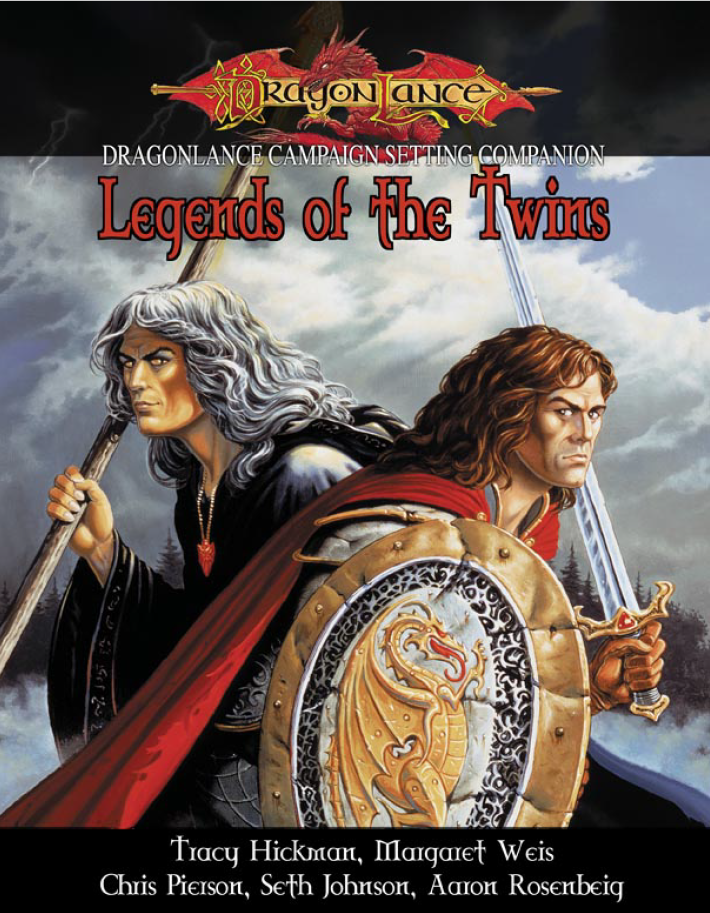
When it comes to gaming, most Dragonlance players are familiar with one of two eras: either the original Chronicles which spanned an epic fantasy against a dragon-themed evil empire, or the Fifth Age which detailed events fifty years after the former. But a new trilogy of books revolving around Raistlin and his brother Caramon’s time-traveling adventures never really got the module adaption treatment. This is due to the fact that it doesn’t really model the typical Dungeons & Dragons campaign. Still, the introduction of not just time travel but alternate timelines of parallel realities were a pretty novel idea. So during the 3rd Edition era of D&D, Margaret Weis Productions released the Legends of the Twins sourcebook as a supplement to the already-existing Dragonlance Campaign Setting (which I reviewed here)!
I was quite enamored of this book back in high school, in that it took the standard world in some neat and novel directions. Want rules for time travel? We got that! How about alternate campaign options, such as the Wizards of High Sorcery taking over Ansalon? You betcha! How about a detailed look at the Abyss, Dragonlance’s planar home of evil deities? We’ve got that too! Want a totally borked stat block of Raistlin at the height of his power, who will most definitely murderize your party if they lose initiative?
...wait, you don’t want that? Well don’t let that scare you! This bad boy’s 210 pages should have something to intrigue you!
Chapter One: Characters
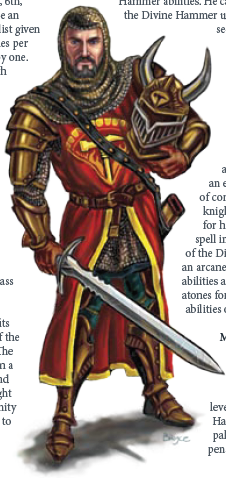
Both of the first two chapters are quite short and PC-friendly, which makes me wonder why they weren’t combined together. Chapter 1 provides some new classes and feats with an optional trait system we’ll be talking about first.
Character Traits are ‘role-play enhancing materials’ meant to showcase some weakness or personality flaw for your PC in exchange for a minor bonus representing a positive side of said weakness. For example, being Abrasive grants you +1 on Intimidate but -1 on Diplomacy, while Slow halves your base movement speed but gives you 1 bonus hit point per level. All in all, they’re not really anything noticeable or special to really change a character and will be of limited utility save among the min-maxers out there.
The books’ new Feats are interesting in that they vary widely in scale. About half of them are the boring +2 to 2 different skills, but divine spellcasters will love Academic Priest and Dynamic Priest which let you substitute your Intelligence or Charisma in place of Wisdom for all spellcasting needs. As Charisma governs turning and rebuking undead, Dynamic in particular is quite popular. Heroic Surge was a reprint from the base setting, but grants you a per-day use of one bonus move or standard action per round to be performed at any time during your regular actions. Said feat was very popular among gaming groups for letting martials make full attacks while moving more than 5 feet. Astrological Forecasting is a rather situational one, where you can read someone’s horoscope once per week and give them a spendable +1 to +3 bonus on a single check any time during the next 7 days. The concept is cool, but the piddly bonus and infrequent rate blunt its use.
For classes we have one base class and prestige class each. The Mariner is our new base class, and was actually an updated reprint from an earlier sourcebook based on fan feedback that the original was too weak. Sadly, there’s not much improved here: the concept is a light-on-their-feet mobile fighter with some seamanship, but nothing that existing classes cannot replicate better. They get fighter-esque bonus feats but only every 5 levels, their Sailor Lore is like Bardic Knowledge but more limited in subject matter, their Dirty Strike is a poor man’s Sneak Attack (max 5d4 at 18th level) and requires a full round action to use as part of an attack rather than adding to every attack you make like Sneak Attack does. The only other features of note are a bonus to some mobility-based skills and a dodge bonus to AC when fighting next to allies.
If this is an improvement, I dread to see the original!
The Knight of the Divine Hammer is our sole prestige class, representing the elite soldiers appointed by the Kingpriest of Istar. Before Dragonlance’s main setting proper, there was a great empire so obsessed with destroying evil that they committed many atrocities to the point that the gods destroyed their civilization. As such, the Divine Hammer’s not really around in modern times and most likely be encountered as NPCs while time-traveling. The class is a noncasting martial variety with mostly role-playing based prerequisites. The class features they gain reflect their imperialist manner, from bonuses on social checks when exercising authority, able to deal nonlethal damage without penalty, Smite Infidel instead of Smite Evil,* and limited use abilities to grant bonuses on saving throws versus fear or physical ability scores, and the ability to impart smaller bonuses to allies at higher levels.
*aka outsiders, spellcasters of all kinds, and certain evil creature types like undead
The Knights can multi-class as paladins and must be no more than one step from Lawful Good, but lose their class features if they act dishonorable or “commit an evil act” which we’ll see later on in this book is pretty much impossible to do by serving Istar’s government. Well, impossible in most campaign settings besides Dragonlance, but we’ll get to that in Chapter Three.
Chapter Two: the River of Time

This chapter delves into the more supernatural aspects, such as how manipulating time works in the Dragonlance setting and new spells and magic items centered around all things temporal. First off, the fluff!
The River of Time is a core fixture of the Dragonlance cosmology, its main current flowing in one direction. However, people capable of traveling back have limited means of making any permanent changes, and all but the most powerful magic allows you to manipulate the past beyond that of an immaterial spectator. The three primordial races* (humans, dwarves, ogres) who go back in time will find their ability to change major events hindered or outright unconstructed once they return. However, if a race which bears the primordial essence of Chaos (aka all of the other races) travels back in time then the River’s immutable nature no longer applies and time paradoxes become possible. The River still has one main ‘flow,’ so even if history is altered then the River will ‘fork’ into a parallel reality where events unfold differently. And those forks can further fork from paradoxes of their own.
*Oddly enough there’s no mention of what happens when dragons time travel, as they are born of the world itself which would technically make them as limited as humans/elves/ogres.
Even the gods are affected by time, and there are alternate Krynns where they’ve become enslaved by the Kingpriest, died or usurped of their power by another, and so on and so forth. But the gods have more control over the River than mortals, able to see potential futures and transport mortals but unable to alter or stop the flow of it themselves.
We move on to new Spells, which are ill-understood and the book recommends not letting PCs automatically learn or prepare for them right out of the gate. Instead they would individually uncover said spells as part of an adventure, along with a sample hook of a researcher losing a book detailing said spells while venturing among the ruins of ancient Istar.
We have 14 new spells, and they’re heavily geared towards being exclusive to sorcerers and wizards. Only 3 can be learned by Clerics, 2 by Mystics (Dragonlance’s divine equivalent to the Sorcerer), and 4 by Druids. I won’t detail each of them and some are merely greater versions of existing ones, but a few of the more interesting spells include Frozen Moment (freeze one creature or object in time), River’s Ravages (rapidly age a creature’s form), Temporal Shield (slow incoming objects to a near-stop, granting you an AC bonus), Temporal Sphere (create a sphere of slowed time around yourself which makes all within invulnerable to outside attacks but can only act every other round), Timeheal (send a living creature’s body back in time to reverse negative ailments), and Time Reaver (Travel 20 years backward or 1 year forward in time per Caster Level, albeit at a hefty cost of money, experience, and the temporary depowering of a major artifact as a focus).
Overall, the spells tend to be utility-focused although the more offensive ones merely debilitate rather than outright damage or kill, and quite a few can be used for defensive measures.
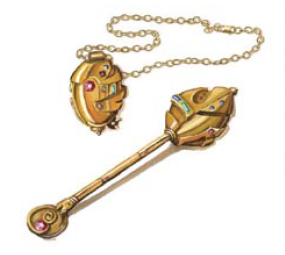
When it comes to Magic Items, we have 11 items and 3 artifacts. Most of them are rather bleh, merely allowing you to cast or use the aforementioned spells or ones from the core rulebook like the Slow spell. The ones which do stand out are the Iron Nail of Iteration (which can be driven into an area with a magical aura and repeat/recast a spell’s effects) and Time Candles (which create a localized Time Stop spell within its illumination, but is one use and has a market price of 306,000 steel pieces* which insures no PC will bother crafting it on their own!
*steel pieces are equivalent to gold pieces in the Dragonlance setting.
Our artifacts are all priceless relics which can perform feats even the aforementioned spells cannot do and are regarded by most as mythical rather than something which actually exists. The Device of Time Journeying is in the possession of the Master of the Tower of Wayreth** and famously used in the Legends trilogy when Caramon and Tasslehoff used it to travel to the past. The Device is virtually impossible to steal as reality itself returns it gradually to its legitimate owner, and you need to repeat a series of verses and puzzle-like manipulations of buttons, rods, and lenses in order to activate. Once this is performed the person merely imagines the era in which they desire to travel, and they and nearby individuals will be transported along the River of Time.
**which is Dragonlance’s sole remaining academy of wizardry and thus the hub for arcane spellcasters.
The Globe of Present Time Passing was invented by Raistlin and gifted to the immortal historian Astinus. You can use the Globe to effortlessly scry anywhere in the present and project yourself in spirit form to said places. It can theoretically be used to peer into the past, but at risk of being more difficult to return to your present era and thus become forever stranded.
The Tapestry of Time was weaved by the gnomes of Mount Nevermind to make predictions of the future. Those diligent enough to maneuver through the infamous gnomish bureaucracy may be allowed to stare at it. By merely gazing upon it without focusing one’s eyes the threads will weave together, depicting a visual recreation of a potential future event. This can only be done once per day per viewer, and the events are not foolproof but rather predict what is most statistically probable based upon current events. Said pictures are highly individualized and different people staring at the Tapestry may see different scenes based upon their query.
Thoughts So Far: Legends’ first chapters have a mixture of features. There’s quite a bit of useful options, but the classes and many feats are of dubious quality. The new spells and artifacts were the chapters’ strong points, and quite useful for the levels at which they can be learned.
Join us next time as we cover Chapter Three, Eras of Legend!
Legends of the Twins
Original SA post
Chapter Three: Eras of Legend
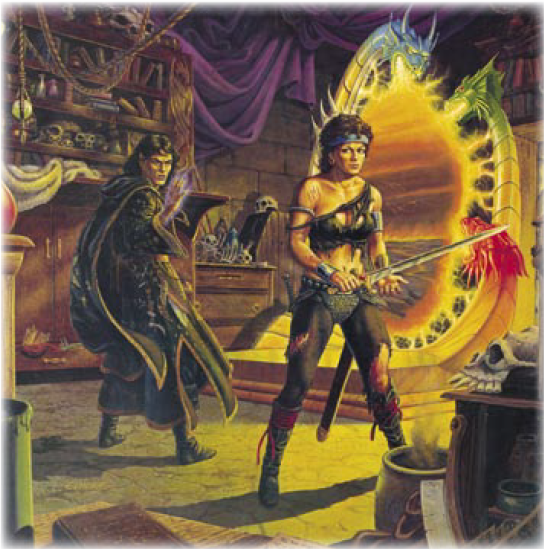
Eras of Time covers in detail three major historical incidents of Dragonlance along with notable people and adventure material, as well as a description of the Abyss and stat blocks for notable time-travelers. It’s no coincidence that said eras were visited in the Legends trilogy at various points, and thus has the most material from the book series. Alas we are sorely lacking opportunities for those wishing to visit Huma Dragonbane or the Dragonwars.
A Time of Dragons takes place after the War of the Lance, aka the main Chronicles series, and spans about 10 years. The forces of Takhisis fractured into ineffectual bands, with the Blue Dragon Highlord Lady Kitiara holding onto a narrow slice of mountains in Sanction as the veritable major threat. The return of the true gods and divine magic means that the continent of Ansalon is undergoing a major religious revival, and the pivotal role Raistlin and other wizards played in fighting the Dragonarmies means that said mages are more widely accepted in society. And the masters of the Tower of Wayreth are worried about what Raistlin’s up to ever since he went AWOL after the War of the Lance. The leaders of the Qualinesti and Silvanesti kingdoms politically unite when their leaders marry each other.
This entry heavily focuses on the city of Palanthas, the largest city in Ansalon. It’s got a big new shiny temple to Paladine, the head of the pantheon of good-aligned deities, and the spooky Tower of High Sorcery has been claimed by Raistlin where he and his apprentice are most surely up to no good. Adventure hooks for this era include mopping up Dragonarmy remnants, infiltrating Raistlin’s tower, tracking down a plague-spreading cult, and playing an escort mission for a Red Robe Wizard heading to Wayreth.
We get some stat blocks, but they mostly include major political power players of varying levels. We have mid-level people like the ruler of Palanthas or Raistlin’s apprentice Dalamar. At the higher end we have the Grandmaster of the Solamnic Knights who is 16th level along with the three leaders of the respective Robe Orders of High Sorcery who are perhaps the most powerful people on Krynn ranging from 17th to 20th level. Two characters from the Chronicles, Elistan the cleric and Tanis Half-Elven the ranger, get their own write-ups. The former is the religious leader of Paladine’s worshipers and has shaped up to be a sterling role model, while Tanis is at peace with his role as a renowned hero and traveling mediator of disputes.
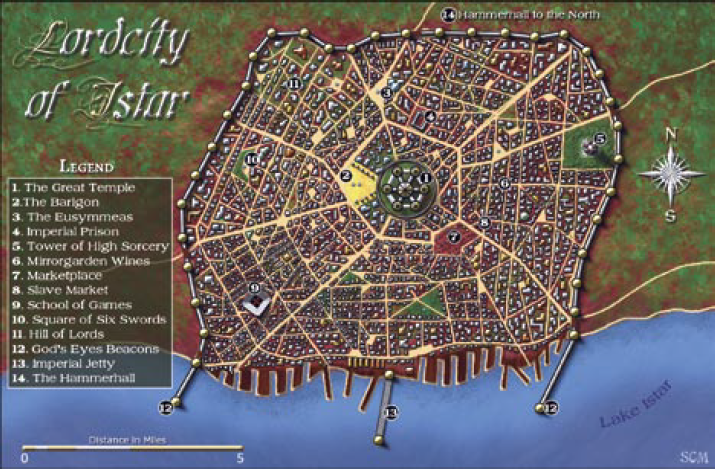
Istar is the archetypical high magic fallen empire which your D&D setting compares itself to as it pines for times of greatness long gone. However, the supposed “golden age” of Istar became less fact and more myth as time went on when it veered from Lawful Good to Lawful Stupid. In fact, Dragonlance’s Istar is pretty much the culmination of all those online debates you’ve seen about alignment. Combine this with a pinch of “both sides” centrism which posits that having too much Good is just as bad as too much Evil, and you’ve got one of the most controversial aspects of the setting.
Brief History: The Holy Empire of Istar had its beginnings as a humble fishing village. In the aftermath of the Third Dragonwar the church of Paladine and the secular nobility combined forces to take over nearby provinces via economic exploitation and trade wars. It is very much a fantasy counterpart Roman Empire with Italian and Latin-style names and titles, and made heavy use of divine spellcasters to supplement public works projects so that even the worst-off citizens have a comfortable standard of living. But things started to deteriorate when increased war funding to vanquish evil wherever it lay in Ansalon taxed the people heavily and led to a brief civil war.
The gods of Good and Neutrality became increasingly disfavored with what the Istaran government was doing in their name and revoked their divine spellcasting privileges among many of them. The clerics interpreted this as a personal trial to instead be more zealous; the crowning of the next (and final) Kingpriest Beldinas stepped this up by doing a variety of controversial measures: declaring wizards of all alignments enemies of the state, reinstituting slavery for criminals, dwarves,* and the evil races, forming a secret police force to mind-read citizen’s thoughts on the streets for impure thoughts, and leading genocidal purges not just against goblins and monsters but also against kender and laying siege to all but one of the Towers of High Sorcery.
*dwarves worship Reorx, who is neutral-aligned.
The final straw came when Beldinas grew dissatisfied when the gods seemed not as bloodthirsty in ‘vanquishing evil’ as he was, and ignored a series of Moses-style warnings. When he conducted a ritual to enslave the gods, he failed and thus they punished him by shooting a mountain from space (aka a meteor) onto the capital city and bringing forth the Cataclysm. This apocalyptic event left millions dead, induced irreversible climate change affecting the entire planet, sent much of the eastern continent underwater, plunged several provinces into chaos and war, and the total loss of divine magic increased the death rate further from now-untreatable injuries and illnesses.
The lesson that Dragonlance’s writers want you to take away from this was that the gods were totally not at fault for the Cataclysm, that the Kingpriest and the Istaran government were not wicked men but people who were too Good-aligned for their own good in spite of all their atrocities, that the gods did not leave Krynn but that the “people left the gods” post-Cataclysm, and that Neutrality is the most tolerant of alignments.
But that’s not here or now. This section proper takes place on the final days of said Empire before the Cataclysm comes. Istar is a walled city with beautiful golden-white architecture, ample public gardens and clean streets with expansive welfare system that all but eliminated poverty and hardship among the non-slaves. It still has lots of foreign visitors and trade in spite of its authoritarianism, and the Arena is one of the most popular social venues. Made up mostly of slave-gladiators, the fights are not lethal but more akin to staged professional wrestling where armor’s lined with blood-filled animal bladders and the “pits of death” merely drop into padded sections of lower catacombs beneath the colosseum. Even so, gladiators can still die from injuries but the slave-masters tolerate this as the cost of doing business, and there’s an underground market of gambling, thrown matches, and poisoned weapons and performance-enhancing drugs.
The Great Temple of Paladine is the Kingpriest’s home and center of government in the entire empire. The Tower of High Sorcery in the city now stands empty, its occupants killed by the Kingpriest’s forces or having escaped via magic. Not one to let a good defensive fortification go to waste, it is now a place where the government houses magic items and relics of non-good religions as well as good-aligned ones which are ‘heretical.’
You might be wondering how Istar managed to penetrate the various Towers’ defenses? Well this is answered in the form of the sneaky Black Robe archmage Fistandantilus. He had lots of rivals among the wizards and figured that using fundamentalist patsies to take them out was a good idea, so he bred magical seeds which could wilt the magic of the Towers’ surrounding groves. Once all but Wayreth were destroyed, he revealed his evil master plan to Kingpriest Beldinas and asked to have a seat as his advisor in exchange for this grand favor. Instead of Smiting Evil or realizing he was manipulated into working for said evil, the Kingpriest honored this request in the belief of “keep your friends close but your enemies closer.” Fistandantilus took advantage of this to create his own secret dungeon beneath the temple where he does secret evil stuff out of the church’s eyes.
So umm, are we really sure the Kingpriest isn’t actually evil-aligned yet, Weis and Hickman? Nope, Beldinas is still canonically Lawful Good and still has cleric spells to boot!
The adventure ideas include saving ‘heretical’ relics, escaping the colosseum as gladiator-slaves, finding a way to prevent the Cataclysm or save as many people in its wake, or even ensure it for some unfathomable reason. The stat blocks for this entry include the Kingpriest (a 20th level Dynamic Priest cleric), , a secret true cleric scribe preserving knowledge, several famous gladiators, and an arrogant elven ambassador because of course a dickish Lawful Stupid empire would be best buds with D&D’s other arrogant asshole civilization.
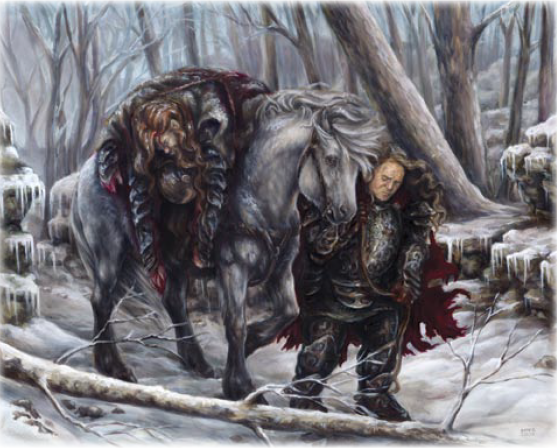
The Dwarfgate Wars tops our three eras. Set a mere 40 years after the Cataclysm, it is a pretty major subversion of Dragonlance’s classic high fantasy themes of daring heroism versus utter evil. Even in this romantic world there are conflicts where there are no real good guys, where both sides have understandable motives and survival is top priority. Istar’s reign is remembered by the older generation, and besides some secluded wizards in Wayreth and monsters with supernatural powers it is largely a world without magic.
The Dwarfgate Wars are the name for an incident where the mountain nation of Thorbadin underwent a major food shortage from the Cataclysm’s destruction of supply lines, farming villages, and trade agreements. And so Thorbadin expelled its lower classes and barred entry to dwarves living outside who are now known as the Neidar clan aka hill dwarves. Human warlords and refugees sought Thorbadin’s resources, while the hill dwarves were angered at being denied access to their ancestral homes at a time when the surface world was more dangerous than ever. Add some factionalism and power-jockeying among Thorbadin’s nobility taking advantage of the power imbalance wrought by the Cataclysm and Solamnic knights oathbound to keep order among the humans, and it all quickly blows up into a series of wars beyond anyone’s control.
The time-traveling Raistlin, Tasslehoff, and Caramon end up involved in said wars as well, with Raistlin seeking Fistandantilus* to kill him and take his power as a means of eventually defeating Takhisis. As Takhisis is the head of the pantheon of evil deities and the true leader of the Dragonarmies in the Chronicles era, this is a mighty tall order.
*who allied with the banished hill dwarves only so he could open a portal to the Abyss.
We get some detailed write-ups of several places of relevance: Palanthas escaped the Cataclysm more or less unscathed, the fortress of Pax Tharkas is taken over by dwarves (was formerly joint-owned between them and the elves), the Plains of Dergoth are home to hill dwarves digging underground tunnels into Thorbadin, the kingdom of Thorbadin itself which is an expansive multi-leveled complex with several cities’ worth of inhabitants, and the forbidden Black Robe fortress of Zhaman which Fistandantilus occupied for a time before it blown up due to Abyssal portal mishaps.
The adventure hooks for this are perhaps the least diverse, most involve interacting with one of the faction armies, raiding Thorbadin or Zhaman, or taking the place of one of the warlords involved. The NPC stat blocks are appropriately all noncasting martials of various political figures and warlords of this time. The notable exception is Gnimsh, an outcast gnome ‘cursed’ to have all of his inventions work properly.* His Life Quest was to create a device which could allow extraplanar travel, and thus was manipulated into building a portal to the Abyss.
*for this leaves no room for improvement and additions to be made by the standards of Gnomish culture.

The Abyss is a bit of an odd entry out, but is important as it is a place ventured to in the Legends trilogy and also one of Dragonlance’s 3 Outer Planes (the other 2 the homes of the Neutral and Good-aligned deities). Dragonlance’s Abyss is not the same one of Greyhawk and Forgotten Realms, but an immaterial expanse of blackness acting as a dark mirror to Krynn. The foundations of its regions are shaped by the Gods of Evil but can also change on a smaller scale to fit the minds and desires of mortal visitors. Space and distance are subjective and shaped more by the willpower of the dark gods and travelers, and is highly toxic to living creatures dealing 1d8 negative energy damage per hour. The plane’s subjective reality can be changed by a visitor via a Wisdom check, with higher DCs corresponding to greater environmental changes.
The only notable places detailed in the Abyss are the domiciles of the Gods of Evil: the disease-ridden Bronze tower is claimed by Morgion; Chemosh’s underground mausoleum is a prison for all those claimed by the god; the warlike Sargonnas’ Red Arena is host to a giant field of monsters and mortals locked in never-ending struggle; Hiddukel’s Shadowed Streets are a Silent Hill-esque city of pitch black, trash-ridden streets which bend in on themselves and the only non-monstrous inhabitants are wicked bands of criminals plotting petty vendettas; the Temple of Neraka is a warped reflection of Istar’s Grand Temple and the center of power for Takhisis; Zeboim’s Grotto is an underwater kelp forest home to monsters of the deep; and the hidden Vault of the Condemned holds souls deemed too dangerous to roam freely even within the Abyss.
Adventure hooks are non-standard on account that one does not simply Plane Shift into the Abyss and thus should be used sparingly. As such the hooks are appropriately epic, such as closing the portal hosting an extraplanar invasion of demons and devils, rescuing an important cleric or champion of Good from an archfiend’s fortress, taking advantage of the plane’s mutable nature to recreate a long-since-destroyed artifact, or an Abyssal incursion into Palanthas granting the wishes of all citizens in the most twisted of manners.
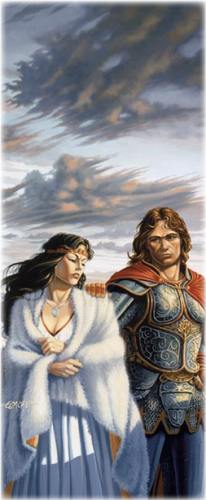
Travelers Along the River is our shortest entry and features the stat blocks of four major time-traveling figures of the Legends trilogy: Raistlin and Caramon Majere, Lady Crysania Tarinius, and Tasslehoff Burrfoot. Starting with Raistlin, he’s pretty much god-tier: he possesses 28 levels total in a mixture of Wizard, Wizard of High Sorcery, Loremaster, and Archmage with use of Epic Spellcasting rules from the Epic Level Handbook. His assortment of spells and possession of artifacts such as the Dragon Orb means that like all high-level wizards he can absolutely wreck a non-optimized party with the right set-up and enough planning. However, his weakly Constitution means that his mere 44 hit points and +9 Fortitude save are his clear weak spots, so in a straight-up fight it really comes down to whether or not he can get the drop on his enemies.
Poor Caramon Majere by contrast is a 14th level Fighter kitted out for melee combat and can’t really do much else. Lady Crysania Tarinius is an up and coming priestess of Paladine who Raistlin manipulated in his quest for power, and is an 11th level Cleric and 3rd-level Noble (PC version of Aristocrat NPC Class). Her spells are geared towards defensive allotment with a few offensive light and smiting spells for good measure.
Finally we have Tasslehoff Burrfoot, who has 5 levels in Rogue and 9 levels in Handler which is a prestige class from another sourcebook. In short, it’s a legendary kender explorer archetype who trades out Sneak Attack in exchange for more defensive measures like adding Charisma to saving throws, picking up various tales like Bardic Knowledge, and can more easily steal items from targets even in combat among other things. While Tasslehoff has some mad skill bonuses in various rogue things, his pitiful 3d6 Sneak Attack means that he’s not going to be punching in his weight class for a 15th-level character.
Thoughts So Far: I enjoyed the write-ups on the eras, although they’re rather narrow in scope. Time of Dragons being set after the Chronicles means that the stakes feel a lot smaller and not as much to do that doesn’t involve one of the setting’s existing major figures (Kitiara, Raistlin, etc). Istar’s brimming with adventure potential against an authoritarian government, but is the crystallized essence of everything wrong with D&D alignment and thus its implementation can be controversial. The Dwarfgate Wars, while instrumental in the Legends trilogy, are a clear departure from Dragonlance’s typical high fantasy. I did like the write-up for the Abyss and the rules for its weird reality-warping nature. The stat blocks for the major Legends characters at the end will see limited use in a campaign: Raistlin’s pretty much a villain at this point, while Caramon and Tasslehoff will be underpowered and boring to play as or alongside if you hitch a time warp ride with them. Crysania is a rather ho-hum Goodly Good Cleric.
Join us next time as we cover my favorite chapter in this book, Alternate Krynns!
Alternate Krynns, Part I
Original SA post
Alternate Krynns, Part I
We talked about time paradoxes and forks in the River of Time, so in this chapter we get six parallel worlds that may have been if some major event did or did not happen and how its ripple effects changed the face of Krynn. It should be noted that the below do not all take place in the same “current era”: Kingpriest Ascendant is in the Third Age, Magocracy of Ansalon takes place during the original Chronicles, Dragonlands and Hourglass in the Sky a few years afterwards, and War of the Darklance and Age of Dragons 30 or 70 years respectively during what would be known as the Age of Mortals.
Kingpriest Ascendant
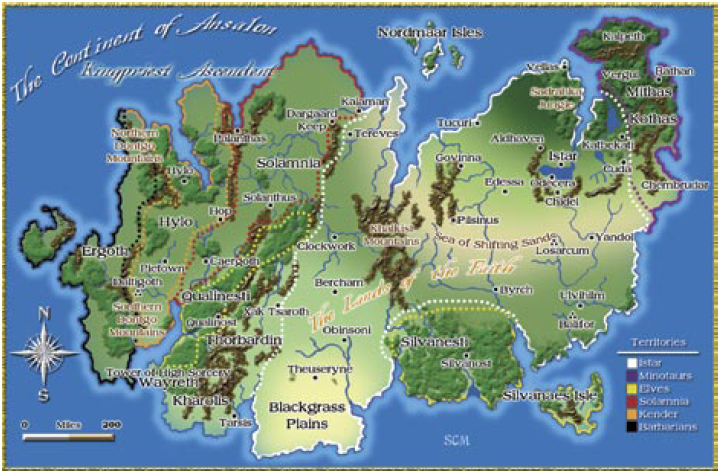
In case you didn’t get enough of Istar dear readers, our first fork along the river posits a Krynn where the Kingpriest’s ritual to enslave the gods was successful. Becoming the Godpriest, he and he alone can grant divine power to mortals and overtook the true gods as the object of worship by the state. And if that weren’t bad enough, while the Cataclysm was averted, the divine usurpation sent a terrible reverberation across Krynn where one out of three living beings died. The Godpriest’s clerics claim that those who perished were weak in the Faith.
Strangely, this near-Thanos Snap is not elucidated on much in the setting. Entire forests and farmland should be dust, and the sudden depopulation of regions will result in a gargantuan power vacuum. And instead of causing violent riots at the Godpriest’s callousness the average citizen...more or less goes along with it. Edit: This all happened last year, so the memories aren't something which faded from the passage of time.
Fun Fact: In my run of 13th Age Dragonlance I used the “1 out of 3” possibility as a rationale for why the gods committed the Cataclysm. And even among the Good and Neutral gods it was a decision that eventually tore apart the pantheons among ideological grounds. I go into further detail on it and other subject matter in this blog post for those interested.
Rather, Kingpriest Ascendant portrays the Empire of Istar as stronger than ever, with the few holdouts on the fringes of the continent. Solamnia, its immediate neighbor, is mightily pissed about the enslavement of the gods to the point that they’re gearing up for war, and wizards are forming a network of underground insurgency cells known as the Burning Robes to strike out at the Faith’s holdings. The Divine Hammer is mostly tasked with foreign affairs, such as fending off and invading minotaur forces in the continent’s far east, while the Brotherhood of Querists (the mind-reading secret police) are becoming more corrupt and violent now that they don’t have to worry about the gods withdrawing their divine magic.
Even the Silvanesti elves thought that this was all too much, so they stepped up spying and reconnaissance to find any advantage they could. Unfortunately for them the Faith developed a magical brainwashing ritual to turn these captured warriors and others into the Purified, entities unquestioningly loyal to the Faith and stripped of all emotion. The minotaurs are enmeshed in a civil war of their own due to Social Darwinism, but at times put aside their differences whenever news of an Istaran army builds up along their borders. Of the nonhuman races the gnomes got the best deal, but their propensity for unpredictable gadgets got them consigned to a reservation-city where they’re free to design and invent with all the government funding they want as a means of lowering incentive for them to go elsewhere. Hylo to the far west is the last refuge of kender on Ansalon, who concoct ever more means of pissing off Istar in a grand social experiment known as the Game. In short you score points for inconveniencing the Faith, be it stealing their holy symbols or filling their braziers with laughing gas.
The Tower of High Sorcery in Wayreth still exists but suffers a declining membership due to the popularity of the Burning Robes. There’s no information about Ergoth, which in Dragonlance was the big human empire before Istar and declined rather than outright fall. It also had Romanesque culture in its later days but its population was notably mostly dark-skinned. In the 3rd and later Ages they were mostly known for expansive trade networks and seamanship, and during the Chronicles kept to themselves. It’s a bit strange to see them excised considering they get mentions in the other Alternate Krynns.
We get three adventure hooks revolving around insurgency against the Godpriest’s reign, be it from kender, clerics of the true gods, or the Burning Robes. A fourth one involves freeing a captured Istaran border town from minotaurs threatening to kill off the villagers and which has been abandoned by the Faith as a military loss. For stat blocks we have a template for the Purified and various kinds of Istaran knights, inquisitors, and the like along with a good-aligned Lord Soth who can make for an ally. The Godpriest is still 20th-level, but now has a Greater Aspect template* which gives him some massive bonuses across the board along with a host of spell-like abilities to supplement his clerical spellcasting.
*from another Dragonlance sourcebook, Holy Orders of the Stars.
Rating: ⅗. Kingpriest Ascendant makes for a pretty cool offbeat campaign where you’re conducting covert guerilla raids against religious fundamentalists. However, as most written material for Dragonlance details later Ages you don’t have as much material to work with for this setting given that the Age of Might references countries and cultures which no longer exist even in the main timeline. The one out of three dead is meant to show the deadly cost of the Godpriest’s rule, but it is reduced to an afterthought for world-building which I heavily dislike.
Magocracy of Ansalon
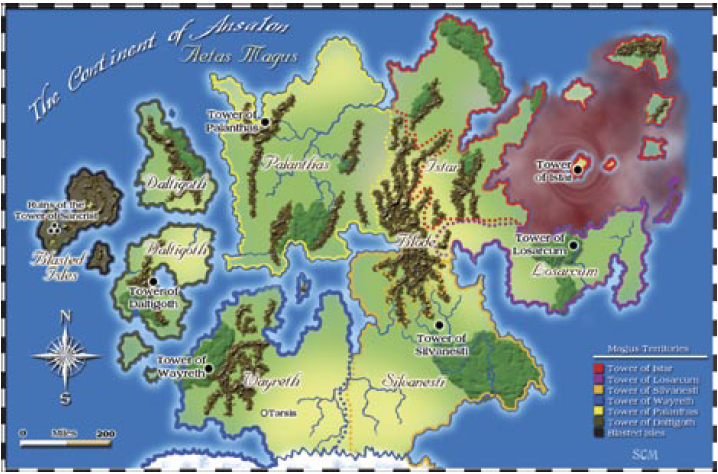
In the main timeline the Wizards of High Sorcery have a strict clause that their higher-ranking members cannot get involved in politics, which isn’t always followed. The historical distrust of wizards means that they have plenty of reason to cut themselves off from an ungrateful world. But in an alternate timeline, when the Cataclysm rent Krynn asunder, the Wizards stepped in to provide safety and order. They used their magic to aid communities where there were no more clerics and defended them against the numerous monsters and warlords. The soldiers who knew better than to pick a fight with someone who can kill them with a flick of their fingers were hired and incorporated into the new societies. And the best of the best became the Knights of Huma, an order of warriors tasked with defending mages and keeping the peace.
In short, the Wizards of High Sorcery became the government in most lands. They acted in theory as administrators and defenders using their superior magical might, and in turn the citizens paid their taxes which could be used for furthering arcane research along with the more mundane government services. For the White Robes it was an act of altruism in making a better world; for the Red Robes it was a rational choice in making their lives easier when citizens were grateful of witches rather than burning them at the stake; and the Black Robes were more than happy to abuse their newfound power like countless spell-less tyrants of times long gone.
The standards of living are higher here than in the standard Age of Despair. Everyday magic is more plentiful and many families encourage their children to learn the arcane arts as a means of social mobility for completing the Test of High Sorcery. But society is still hierarchical, for all high-ranking positions are held by mages and the six major countries are large administrative regions named after the Towers of High Sorcery. Clerical magic is unheard of, and Takhisis is still plotting to make a Dragonarmy. But instead she uses a secret order of Gray Robe Wizards loyal to her in lieu of evil clerics.
We get a detail of the lands after the general history: the Solamnic Knights still exist but resent the mages’ ascendancy and fight them from the southern city of Tarsis, while various exiles wanting to be free of mages make new lives on the nearby Plains of Dust. The Tower of Istar was teleported away during the Cataclysm and now looks over the Blood Sea created in its wake from the safety of an island. The elven land of Silvanesti has a memorial dedicated to the names of mages who gave their lives saving people during the chaos of the Cataclysm. The Blasted Isles of Sancrist are a magical Bikini Atoll where repeated testing of dangerous spells warped the land with aberrant creatures and unnatural phenomena. The mountainous ogre nation of Blöde is a place no mage wants to govern and thus Takhisis’ gray robes are slowly building up Dragonarmies there for an eventual invasion of surrounding lands.
Adventure hooks include an escort mission for Dalamar the White to the Blasted Isles for a Test of High Sorcery at the Tower there, hunting renegade mages in Blöde, and saving a wizard from an execution at the hands of Solamnic Knights. But the hook which jumped out the most to me was a recreation of the opening of the Dragonlance Chronicles: a disgraced wizard seeks the hands of the true gods after losing faith in the current order and seeks to claim the Disks of Mishakal said to lie below the Blood Sea of Istar. But this time it won’t just be Takhisis’ Dragonarmies who object to this; the established Orders of High Sorcery have no intention of upstart clerics challenging their power.
We get write-ups and brief stats for each Tower (and therefore national) leader as well as the respective leaders of the Knights of Huma and Solamnia. We get some interesting world-building in their entries: my favorite is having the normally anti-arcane minotaurs be the first people to embrace the magocracy on account of having a shared history of oppression by Istar and respecting how the mages established themselves as the new power.
Rating: ⅘. Magocracy of Ansalon is a cool and innovative spin on Dragonlance based off of a common question asked by successive generations of D&D fans: why don’t spellcasters use their powers to rule everything? There’s some build-up of a high magic War of the Lance in the hooks, although given the iconic nature of said adventures it’s the kind of thing that would best be run with a veteran set of Dragonlance gamers who can spot the minor changes and references. It doesn’t have a central overarching villain at the onset, unlike the other Alternate Krynns which can allow for a wider variety of campaign styles.
Dragonlands
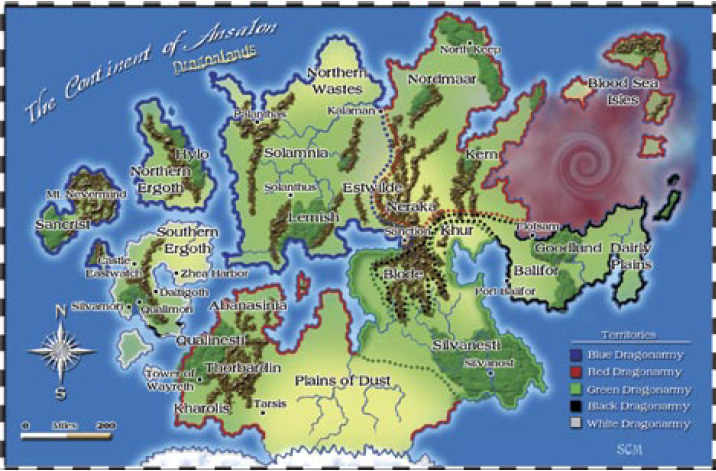
The Dragonlands can be best surmised as what happens when you get a Game Over/TPK when running the Dragonlance Chronicles. Without the Heroes of the Lance to stop the Dragonarmies, Takhisis takes over the continent of Ansalon with eyes towards the rest of the world! But since we cannot predict whatever rag-tag group of ogre druids and gnome assassins were part of your local gaming group, this timeline’s canon is going with the characters from the books. The major turning point in this campaign was during the Battle of the High Clerist’s Tower, when Sturm Brightblade became overwhelmed by dragonfear. Without his stalwart example and heroic sacrifice, the Knights of Solamnia’s morale gave way and lost the Tower and thus Palanthas to the Blue Dragonarmy. The metallic dragons never learned of the plight of their kidnapped eggs (which were being used to make draconians), and when Theros Ironfeld disappeared the secrets of forging Dragonlances were lost.
Now all of Ansalon is made to give praise to the Dark Queen Takhisis, its formerly-free nations carved up as territory between the five Dragonarmies. Now new heroes must answer the call in an even deadlier world where the last vestiges of resistance (deposed governments in exile, Solamnic Knights, non-evil clerics, etc) are separate bands of resistance constantly on the move, outnumbered and outclassed.
For those interested in what happened to the Heroes of the Lance: Elistan died from an incurable disease, Riverwind and Goldmoon were slain by barbarian mercenaries, Laurana was driven mad by desperate use of the Dragon Orb in the High Clerist’s Tower, Raistlin turned evil and stole a Dragon Orb of his own before disappearing to who-knows-where, Flint died from a stroke, Caramon and Tika become trapped in an unhappy marriage, Sturm is a disgraced and broken man, and Tanis is too busy looking over his remaining friends to restart the fight against the Dark Queen’s forces.
Setting locations are sparse and readers are pointed to the existing War of the Lance sourcebook where things remain relatively unchanged. The notable exceptions are the High Clerist’s Tower, guarded over by the spirits of slain dragons summoned by the Dragon Orb where Laurana’s mad melodies can be heard; the administrative regions of the Dragon Empire; a secret rebel base in the mountains known as Sanctuary occupying a temple which shows historical evidence of the existence of good-aligned metallic dragons*; the nightmare lands of Silvanesti are used as a dumping ground by the Dragonarmies for elven prisoners across the continent; a secret temple holding a dragon-slaying arrow which will only reveal its gates to a cleric of the non-evil gods; and the Tower of Wayreth’s wizards are locked in furious debate as to whether or not to intervene in the outside world given that it’s only a matter of time before the Dragonarmies come for them.
*Dragons were considered mythical beasts during the War of the Lance, and for most of the Chronicles only Chromatics were known.
Some of the more interesting adventure hooks include seizing the Blue Crystal Staff from a highly-secured transport, Sturm giving his sword to one of the PCs for a quest to rediscover the ancient forge of the Dragonlances, and papers from a dying soldier showing of an intrafactional assassination attempt against the Green Dragon Highlord. The NPC write-ups are a diverse assortment, ranging from freedom fighters, a demoted Dragonarmy desk clerk using the bureaucracy against the Empire to cause supply shortages and mishaps, a gnome weapons designer who invented an automatic Gatling crossbow (but no stats for said new weapon), an in-character write-up of Fewmaster Toede* who portrays himself as THE GREATEST SOLDIER OF ANSALSON, and Sturm Brightblade who is now a shadow of his former self.
*an arrogant and utterly ineffectual recurring comic relief villain in the Chronicles.
Rating: ⅘. It’s not exactly that much different than the original Chronicles, but everything’s worse since evil has won. The adventure hooks, NPCs, and location material strongly point to the PCs picking up where the Heroes of the Lance failed, which can make for an interesting “second try” for those who suffered a TPK during the Chronicles. The baked-in nature of existing book characters means that things will need to be changed around to account for things like if Sturm was never a PC in your games.
Due to the length of this chapter, the second half of Alternate Krynns will continue in a future post.
Alternate Krynns, Part II
Original SA post
Alternate Krynns, Part II
Hourglass in the Sky
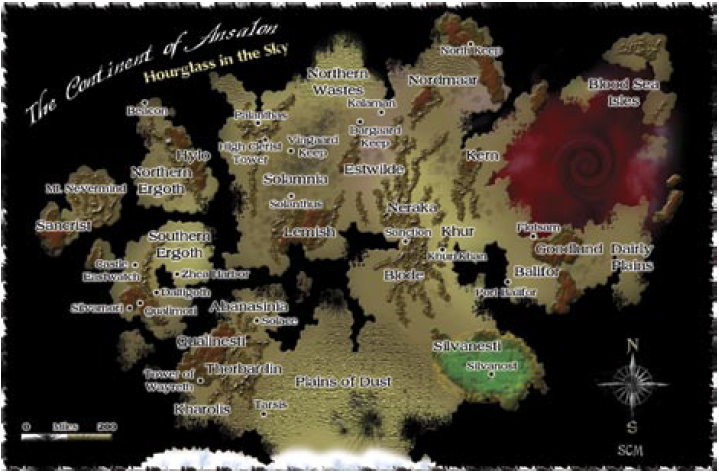
The world is doomed. DOOMED! This alternate timeline details what would happen if Raistlin’s quest for power culminated in him killing off the gods of Krynn and what happens in the meantime. Unlike previous timelines this one’s a lot shorter as the world will literally end in two years once Raistlin slays the final god Paladine, with entries detailing days of the month instead of just year by year. Taking place three years after the end of the War of the Lance, Raistlin slays Takhisis while an ascetic of the Library of Palanthas steals the Final Volume prophesying Krynn’s final days with startling detail. Circulation of the book spreads rapidly once Raistlin kills more gods, causing terrible weather known as magestorms to sweep across the world. The three moons shatter once Raistlin kills the first of the three gods of magic. What follows is a series of natural and unnatural disasters, political upheaval once knowledge of the Final Volume spreads, and the rise of Raistlin-worshiping cultists which culminates in a wide displacement of refugees and survivors seeking the few safe places left on Ansalon. The world gets progressively worse in more supernatural ways, from literal rains of blood raining across the northern half of Ansalon, a lightstorm resurrecting former Dragonarmy soldiers who don’t know what the hell’s going on and renew their old battles, to larger magestorms covering wider surfaces of the planet the closer the end of history approaches.
We get some write-ups on existing organizations, but what is of paramount interest are two new ones: the first is the Armies of Reorx, a united coalition of dwarven soldiers super-pissed that Raistlin killed their dwarf-god and are fighting the Raistlinites. The second are the aforementioned Raistlinites, who believe that they will survive the end of the world should a lightstorm resurrect them and so are pitching in with the winning party. They’re pretty much your garden-variety evil cultists who can use both arcane and divine magic; they range from community leaders with good publicity to eldritch-powered bandits.
We get several new rules reflecting the apocalyptic state of affairs. The first are magestorms, violent thunderstorms whose lightning strikes cause magical phenomena ranging from instant death to the creation of nightmares and warping the bodies of those struck. Lightstorms are a rarer variety whose rain has healing properties, where its lightning strikes can bring the dead back to life. If it hits no dead material, the lightning spontaneously generates good-aligned animals. It is theorized that the lightstorms are the spark of Crysania who lives on inside Raistlin.
The second rule involves the deaths of the gods. Raistlin’s own constellation gradually grows one star with every act of deicide, and divine spellcasters of a dead god find their magic power waning over the process of 1 Caster Level per day and must roll a Fortitude save vs fatigue whenever they cast a spell. This includes arcane spellcasters who worship one of the three moons, so it might be a good idea to pick a patron deity who gets killed off late in the campaign. Additionally, Raistlin unconsciously passes some of his power to those like himself: non-good-aligned creatures receive bonus HP equal to (4 minus their Constitution bonus, minimum 0) times the number of stars in the sky. This is meant to be a metaphysical act of sympathy for the weak and sickly people like himself, but this means that local wildlife and small woodland creatures get super-buff over the course of the campaign.
Adventure hooks include appropriately out-there ideas: ideas include piloting a gnomish vessel designed to catch pieces of falling moon, finding a magical rose in Lord Soth’s possession which can regrow desolate wastelands, thwarting a plot by clerics of the death god offering to plane shift refugees to what they claim is a safe haven, and helping lead the Armies of Reorx in a vain, supremely risky plan to surround and kill Raistlin. Character write-ups include the scholar of the Final Volume looking for someone to prevent said events, a Solamnic knight in over his head when much of his superiors up the chain of command got killed, a widowed Tika who donned her husband’s gear and seeks to confront Raistlin once he returns to Solace as detailed in the Final Volume, and full write-ups for the Raistlinite cult leader and his warlord second-in-command. We know that as a deity Raistlin has the Evil and Magic domains, but little beyond that.
Rating: 5/5. This is my favorite of the Alternate Krynns. The end of the world scenario is both easy to understand and provides a literal countdown clock for the PCs to accomplish whatever good they seek to do in the world, however futile it may be. The locations, characters, and rules all reinforce this theme in a more punctual way than the Kingpriest Ascendant or Dragonlands’ underdog stories do.
War of the Darklance
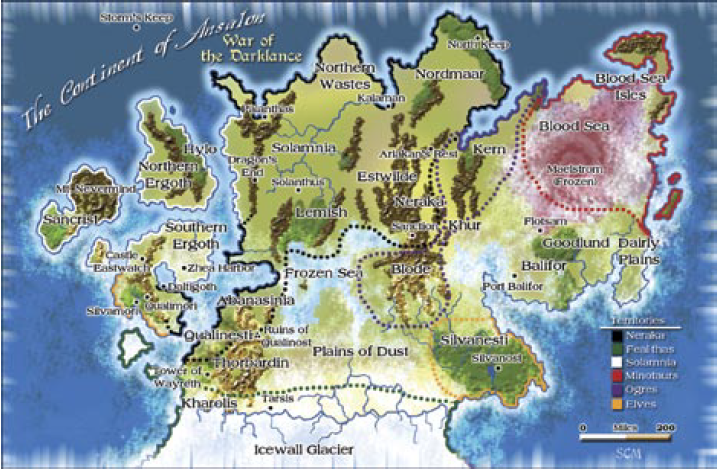
Fun Fact: this alternate timeline was originally a homebrewed setting, but someone in Sovereign Press (the publisher which later became Margaret Weis Productions) liked it so much they asked the creator if they wanted to include it in an official sourcebook. A more complete 208 page PDF is available on the Dragonlance Nexus site.
In the standard Dragonlance timeline, the new Age of Mortals is ushered along when the Graygem of Gargath breaks and releases Chaos into the world. This results in a rare time when the forces of both Good and Evil cooperate against this existential threat which would destroy reality as they knew it. But in War of the Darklance, the Graygem is never broken; therefore the Knights of Takhisis, the spiritual successors to the Dragonarmies, have no such incentive for cooperation and instead try to take Krynn over again.
Taking place around 30 years after the end of the War of the Lance, both arcane and divine magic is widespread enough that armies are beginning to make us of spells for defense, and the Knights of Takhisis begin to steal Dragonlances to corrupt them into Darklances. Such foul magic is so evil that it begins to affect nature, resulting in an unnaturally long continent-wide winter. The Blood Sea of Istar freezes, and the minotaurs march forth on the ice to wage genocidal war against the ogres. Without the unifying pact of the Whitestone Council from the War of the Lance, the Solamnic Knights have their hands full while refugees are arriving in Northern and Southern Ergoth in massive groups for they are the only countries untouched by the Dark Queen’s onslaught. The forests of the Qualinesti elves get burned by the evil Knights, forcing them to flee their homeland once again. The Knights of Takhisis conquered most of the continent, and granary stocks are running ever more dangerously low.
Location write-ups include a Solamnic waystation that made an unlikely alliance with a Black Robe wizard to defend travelers from the Knights of Takhisis; various governments in exile formed settlements in Ergoth, Solamnia and Qualinesti included; the Blood and New Seas froze over with permafrost allowing for strange inhabitants to make their homes in icy caverns; Feal-Thas the White Dragon Highlord became undead and converted Icewall Castle into a flying citadel in the polar south; the gnomes utilize their technology for the war effort by cooperating with the Solamnic Knights; and the Tower of High Sorcery of Palanthas was destroyed by the Knights of the Thorn* in a deadly fight with the Wizards. The forces clashed over the Tower holding a portal to the Abyss, which the Knights could use to free their goddess.
*arcane casters of Takhisis’ Knights.
We have eight whopping adventure hooks, the most of any Alternate Krynn were it not tied with Age of Dragons. They mostly involve thwarting plots against the Knights of Takhisis by seeking aid from some faction or following up a rumor of stolen Dragonlances or saboteurs. But the most interesting one in my opinion involves boring through the Blood Sea’s ice to raid the sunken Tower of High Sorcery of Istar. We have a lot of character writes-ups and stat blocks too. The more notable ones among our selection include Emperor Ariakas’ son, Ariakan, who is a 20th-level martial character specializing in leadership-based buffs derived from his prestige classes; Aren Feal-Thas who is a cold magic-focused wizard and gish with the death knight template*; an evil gully dwarf cleric of Morgion who is spreading filth and disease on purpose; and a motley assortment of notable dragons, regional and military leaders of the various factions, more notable soldiers, draconian assassins, warpriests, and others whose talents are invaluable to the war effort.
*think Lord Soth.
Lastly we have a side-bar going into detail on the creation of Darklances as a twisted reflection of the process used to forge the Dragonlances. Sadly no game stats on how Darklances differ from their original counterparts is provided. I can’t help but feel that this is a wasted opportunity.
Rating: ⅗. While I appreciate it when official companies honor their fanboys by adopting their work, the War of the Darklance is too...well samey for my tastes. Instead of the Dragonarmies, you have the Knights of Takhisis. And instead of Emperor Ariakas they are lead by his son Ariakan. The Qualinesti elves become refugees again. The corrupted Darklances and the continent-wide winter is a novel touch. For the Krynns with similar threats, the Dragonlands at least were based on a clear loss factor, and the Magocracy of Ansalon is different enough to feel novel even if they’re using arcane Dragonarmies.
But I will give it some pluses: I like it more than the default Age of Mortals that came after Dragons of Summer Flame, which more or less was an attempt at nullifying everything that happened in the Chronicles. The large amount of material serves as useful gaming aids, and combined with the linked PDF is the most developed of all the Alternate Krynns.
Age of Dragons
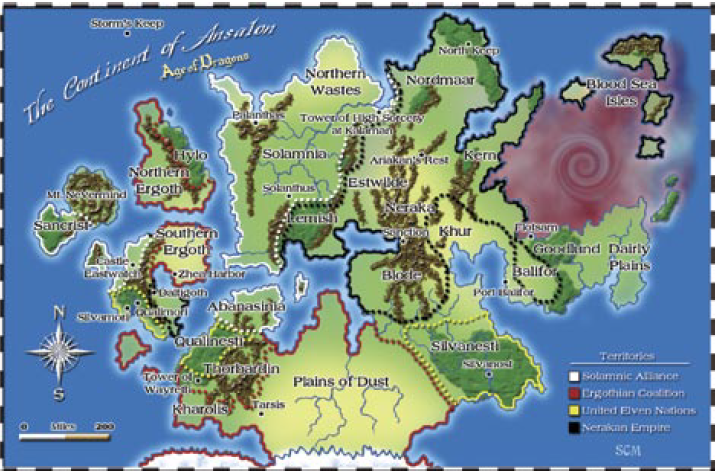
This Alternate Krynn was present in the Legends novels (same with Hourglass in the Sky, although only its aftermath), where Tasslehoff traveled to the future and attended Caramon’s funeral. It takes place in the most current year of the published Dragonlance material, 70 years after the War of the Lance to be precise, but its major divergence point is that Chaos was defeated and Takhisis did not steal the world away to claim for herself. In essence, this bypasses the War of Souls trilogy resulting in a highly different Krynn.
Unlike the other Alternate Krynns there is no major threat arising to menace Ansalon. Instead there is an uneasy peace, where new nations arose as united political blocs: the Ergothian Coalition takes the role of a neutral power, the Solamnic Alliance and the Nerakan Empire are stockpiling arms for yet another war they feel will come, and despite their separation the three elven subraces came together as the United Elven Nations. The United Realms is a pseudo-UN organization dedicated to arbitrating disputes, and the region of Khur (pseudo-Middle East) refused to join in favor of isolationism. The minotaurs and dwarves express little desire to join as well, although the hill dwarves sent an ambassador of their own to the United Realms whilst the minotaurs are eager to invade Ansalon regardless of how its geo-political borders are drawn. The former Grand Master of the Knights of Solamnia died under suspicious circumstances, Neraka’s leader survived his own assassination attempt, and dragons have begun to gather in both nations claiming to be observers of how future events will unfold.
Location-wise we focus mostly on the ‘big picture’ of nations rather than individual places of interest. Some major developments include the Nerakan capital declaring itself a “free trade haven” to boost foreign investment and tourism, the citadel Storm’s Keep is the headquarters of the Knights of Takhisis, the Tower of High Sorcery at Kalaman is built in Solamnia as part of a more open policy to wizards, and the Thieves’ Guild in Palanthas is growing more powerful while the Solamnic Knights are struggling to build reliable kender-proof jail cells in the city.
Our eight adventure hooks have appropriately cloak and dagger politicking themes, ranging from the draconian nation of Teyr being suspected of kidnapping a Solamnic noble to secure a peace treaty, rooting out underground arms dealers selling to minotaurs, and some sillier ones such as a rampaging gnome-created clockwork dragon laying egg bombs or an upstart gully dwarf chieftain bringing Thorbadin to near-civil war by stealing the Hammer of Kharas.The nine stat blocks include write-ups for major political figures and ambassadors. The most notable ones include a souped-up Dalamar who’s the Master of the Tower of Palanthas, and a traveling red robe wizard looking for lost artifacts, texts, and places of arcane significance.
Rating: ⅖. I will admit that Age of Dragons is not really my thing. On the one hand I can see how it cuts down on world-destroying events which at this time in Dragonlance feel old hat, but the murky political intrigue is something I feel does not suit the setting. I can get all this from Eberron’s backdrop; when I run a game of Dragonlance, I want classic high fantasy even if it doesn’t involve the original Chronicles. On the other hand, this setting does have a sizeable fanbase if a Dragonlance Nexus expanded entry and an RPGnet thread are anything to go by.
Thoughts So Far: I appreciate how each Alternate Krynn is both very different from the base setting while also having concepts which can be summed up in quick soundbites. I also enjoy how several of them are willing to give unorthodox antagonists beyond Takhisis’ forces. Hourglass in the Sky was my favorite, with Magocracy of Ansalon a close second. I see potential in Kingpriest Ascendant and Dragonlands, although War of the Darklance and Age of Dragons didn’t really grab me. But even in the latter case the book did a good job of being clear in worldbuilding and generous with gaming aids.
Join us next time as we cover Chapter Five: Legendary Wars!
Legendary Wars
Original SA post
Chapter Five: Legendary Wars
Dragonlance is in many ways a war story. Large battles took place in the original Chronicles, and said modules and others utilized TSR’s BattleSystem for players to run sieges and skirmishes of their own as part of (or apart from) their more regular dungeon-delving faire. In Legends of the Twins, we look at several notable struggles: the Lost Battles, The Dwarfgate Wars, and the Blue Lady’s War.
When this book was released in 2006, there were quite a few fantasy strategy games on the market. Wizards of the Coast was pushing its D&D Miniatures line heavily whose streamlined D20 System rules simulated small-scale warfare. Malhavoc Press published Cry Havoc which had high production values for a 3rd party sourcebook. And this is not counting the many independent wargames existing outside of the D20 framework. Instead of committing to one system, Sovereign Press/Margaret Weis Productions opted to let DMs use their own rules of choice. And to help get a feel for proper conversion, Legendary Wars provides outlines for terrain, troop numbers and divisions, and overall abilities of leaders and units in general 3rd Edition terms.
The three battles are formulaic in their approach: they outline the time periods, the pretext for how said wars came to be, the stakes at risk for both sides, bird’s eye views of battlefield maps and troop movements for longer campaigns, and the results of the battles as they occurred in the Dragonlance canon. Each major army lists a Commander, its composition listed as the number of Brigades, and Minor Commanders and the average brief stat block (race/class/level/alignment) of the Soldiers comprising individual Brigades. The masses of soldiers are a bit all over the place in terms of scale; light infantry and cavalry tend to be 1st level Warriors, while heavy infantry and cavalry can be 1st or 2nd level Fighters. A few notable exceptions, such as Thorbadin’s dwarves, can go up to 3rd level. Specialized units may have 2 levels in a more unorthodox class, like Cleric for battle-priests or Wizard for arcane defenders of the Towers of High Sorcery, while “elite units” or very rich civilizations often have soldiers in masterwork gear.
For those non 3rd Edition players among our readers, the difference between a Warrior and a Fighter is that the former is meant to represent rank and file mooks who only gain more Hit Points and attack bonuses as their major level up rewards; meanwhile, Fighters gain access to lots of bonus feats and are considered a proper PC class. 3rd Edition has been a bit strange in this regard: the PC classes are meant to represent exceptional individuals, while NPC classes like Warrior are meant to portray the common clay of civilization. Higher-powered settings like Faerun subvert this, although Dragonlance post-Age of Might is meant to be a more down to earth low-magic setting.
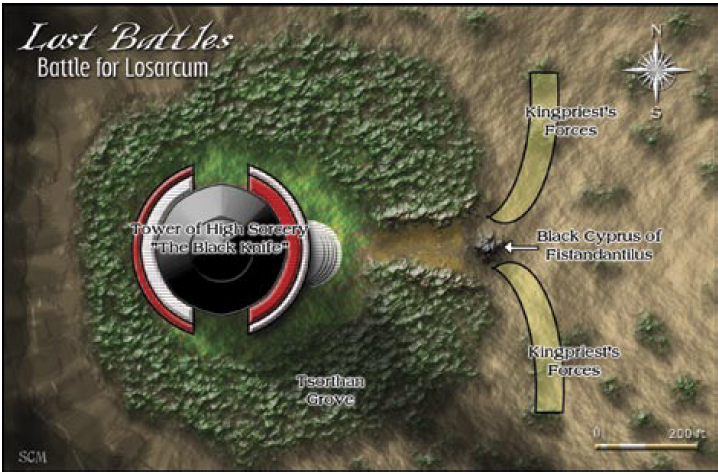
The Lost Battles: This is not a singular event so much as a procession of events. Back during the Age of Might, the Orders of High Sorcery were the other major magical power of Ansalon besides the Kingpriest’s government. However even back then the wizards were stand-offish and more concerned with expanding the knowledge of magic for its own sake than setting up their own kingdoms. Even the villainous Black Robes were more likely to be creepy necromancers, charlatans, and graverobbers than heads of state. Maybe a cult leader, but that’s stepping on the toes of evil clerics.
But in spite of their otherwise neutral stance in world affairs, the Kingpriest feared their power. A series of internal dissensions and increase of authoritarian laws against both evil and “evil” races culminated in an assassination attempt of the Kingpriest by a regenade mage. His actions instead took the lives of two Ergothian princes, and the Order of High Sorcery apprehended said wizard to dispense their own punishment as part of a long-standing policy of self-policing. But the Kingpriest whipped up public sentiment against the wizards due to this being a threat to his divine authority, while also gaining the aid of Solamnia and Ergoth in this matter. Once Fistandantilus covertly weakened the defensive groves, Istaran forces marched upon the Towers.
I have to admit that this is an interesting fact as to why the Kingpriest was killing non-evil wizards. It’s not due to some superstitious “book-magic is evil!” but rather a more cynical means of realpolitik to eliminate the only major domestic faction which could challenge his power. The fact he manipulated the assassination attempt to his advantage once circumstances aligned to put another foreign power* on his side makes Istar look even worse than it already could be, what with the whole sparing of Fistandantilus once said archmage revealed his hand in the whole affair.
*Ergoth in this case.
For army outlines, we have a sample battlemap of the Tower of Lorsacum, which has its own malachite guardian* golem constructs dual-wielding scimitars as major military units with regular D&D stats; and a joint Ergoth-Istaran siege upon the Tower of Daltigoth. The Kingpriest’s forces include a mixture of regular warriors along with Knights of the Divine Hammer and auxiliary clerics, small numbers of mounted Ergothian cavaliers who have masterwork equipment, and the Knights of Solamnia who are heavier on the martial side in comparison to Istar but have some divine casters among the Knights of the Sword. The Orders of High Sorcery are far less in number but should be treated as their own brigades on account that they have many means of using long-duration and AoE spells along with summoned and planar bound monstrous minions to aid them.
*including a new stat block!
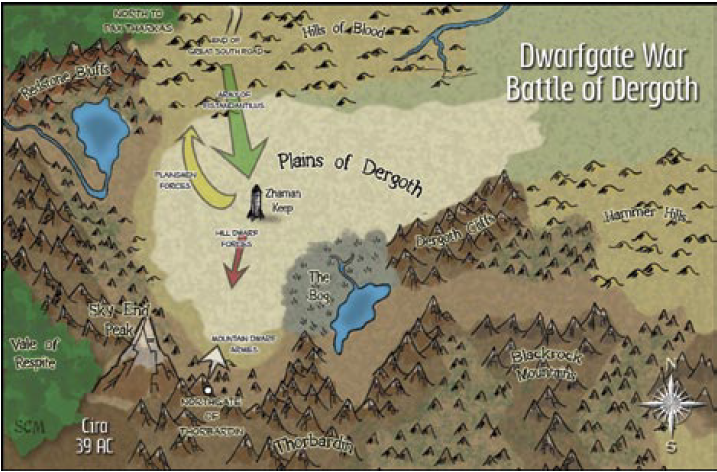
The Dwarfgate Wars: Although far briefer and with far less casualties than other major battles of Krynn, the Dwarfgate Wars are a vital part of the formation of modern dwarven culture. There isn’t much new things here that weren’t covered in Eras of Legend, but there is mention that the concept of Fistandantilus leading his own army is a bit of a modern myth. He was a popular figure and advisor in times of battle, but his so-called “Army” was a disparate collection of Neidar dwarves, Plainsmen, and mercenaries of various races who followed their own commanders who all happened to share common cause in breaking open the gates of Thorbadin.
An interesting thing to note is that dwarven military units are hard as fuck. The average Neidar heavy infantry are 3rd level Fighters, with light infantry 2nd level Warriors. They and the Plainsmen are worse-equipped than the nations of old in the Lost Battles, more likely to have leader and hide armor and wooden shields instead of the chain shirts, chainmail, and steel shields of prior centuries. Barring Fistandantilus there are no spellcasters of any sorts, not even mercenary mages, although there’s mention of a cleric known as Brother Denubis.* It’s very much a down and dirty war, and the text makes mention that although war gear is plentiful starvation and basic necessities are more likely to be stolen and looted than bartered for or purchased.
*who would canonically be a magic-less heathen cleric at this point in history, no matter his patron deity.
The mountain dwarves of Thorbadin by contrast are well-equipped. Even their light infantry are 3rd-level fighters outfitted with masterwork gear (all that talk of dwarven craftsmanship isn’t just for show), with only irregular conscripts among the Klar clan and Gully Dwarves having levels in the inferior Warrior.
Although taking place over a span of years, there were two major battles. The first was the Siege of Pax Tharkas, where said fortress was not enough to hold back the masses of tens of thousands of desperate starving warriors. This was thanks in no small part to Fistandantilus cutting a deal with the Dewar (evil traitorous mountain dwarves) to kill the gate guards and sabotage the defenses. The war climaxed with the final Battle of Dergoth, where Fistandantilus’ abortive attempt to open a portal to the Abyss in the fortress of Skullcap resulted in a gigantic magical explosion which indiscriminately tore through all sides. The mountain dwarves retreated, and the hill dwarves and human forces were too low in number to carry on the battle. Indeed it was Fistandantilus’ actions that convinced dwarves on both sides never to trust a wizard again. Say what you will about Dragonlance, but it gives actual historical basis for some of its class/race combo restrictions.
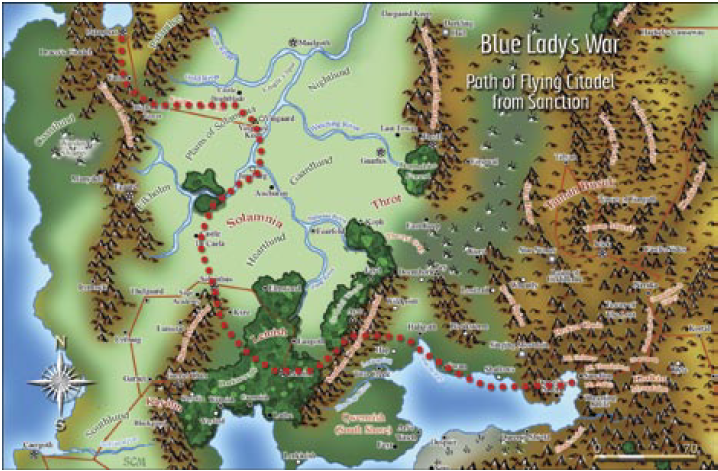
The Blue Lady’s War: After the end of the War of the Lance, the gods returned to the world. Takhisis’ Dragonarmies were beaten back by the forces of good, with only Lady Kitiara’s Blue Dragonarmy holding onto territory of any significance in mountainous central Ansalon. The other Dragonarmies were reduced to ever-splitting factions of desperate banditry or consumed in their own civil wars to the point that they could not challenge the free realms again.
Lord Soth, in spite of being on the side of evil, was no fan of Kitiara. And Kitiara, once Emperor Ariakas’ virtual second in command, wanted to take his place one day and had dreams of restoring her forces to greatness. When she learned of Raistlin’s desire to amass enough magical power to challenge and kill Takhisis herself, a seed of genuine worry erupted within her. Using Soth as an intermediary to contact Raistlin’s apprentice Dalamar, a series of double agents crossing double agents resulted in Lady Kitiara staging an invasion attempt of Palanthas by using a flying fortress. Both sides had their reasons for victory: Palanthas was more prosperous than ever, its deep-water harbor and surrounding mountains made for great natural defenses, and the High Clerist’s Tower was now stocked with Dragonlance-bearing Solamnic Knights. Meanwhile, the aerial advantage of the Blue Dragonarmy’s forces would render said natural defenses moot, and the Tower of High Sorcery of Palanthas was where Raistlin would allegedly perform said ritual of deicide.
This battle’s military units are perhaps the most unique of this chapter’s. The Blue Dragonarmy includes a mix of humans and monsters, ranging from draconians and blue dragons to undead minions under Lord Soth’s command, and an evil-aligned 1st-level gully dwarf by the name of Rounce (who was a character in the books). We even get age categories for the dragons so we can get a sense of their power and how dire things are for the forces of Good.
The Knights of Solamnia are the best of the best of Palanthas: while their gear isn’t always masterwork, they have a mixture of Fighter and Warrior levels, and a privileged few have honest to god bronze dragons to ride upon to challenge the Blue Dragonarmy’s aerial dominance. The City of Palanthas has its own militia who while overall worse skill-wise than the Knights (1st- level characters only, no clerics nor dragons) are willing to defend their homes and equipped with masterwork gear thanks to their city’s prosperity.
The major battles in the Blue Lady’s war includes a failed defense of the High Clerist’s Tower, and battles in the streets of Palanthas where dragons, undead, draconians, and clerics of Paladine engage in street-to-street battles. On the non-army side of things, Caramon and Tanis undertake a stealth mission onboard the flying citadel and eventually commandeer it by...turning the structure upside-down at the pilot controls and shaking it free of remaining draconians. Meanwhile, Dalamar and Kitiara engage one on one in the Tower of High Sorcery, which is what the cover image of Eras of Legend in an earlier post portrayed.
Chapter Six: A Legends Campaign
You may be thinking that this two chapter post is like the opening. Well you’d be half-right: the preceding Legendary Wars is a semi-fair length, but the final main chapter of this book is only five pages long. It’s mostly open-ended advice on how you can flavor your campaign to be more like the Legends trilogy.
The Legendary Campaigns section posits several styles: Traditional has no time travel elements for the PCs to use but rather manifests in an indirect manner: seers, oracles, other time travelers from Alternate Krynns or elsewhere in the timeline can be used to give hints to things beyond the here and now. Some may even seek to fork the River off course while the PCs do their best to keep the status quo of continuity. This kind of campaign is actually discouraged because the book outright points out it wouldn’t make full use of its own contents!
Time Travel is exactly what it says on the tin: whether by virtue of having or being a high-level Sorcerer/Wizard or falling into possession of the Device of Time Journeying, the PCs can travel through time. It suggests that the Dungeon Master map out and express their desire for certain periods or eras rather than having the PCs go to wherever; time travel should be done with a specific purpose in mind, whether that’s to undo a tragedy,* find the answer to some dilemma which can only be found in prior eras, and likewise. It’s also encouraged for the DM to show that even though Dragonlance has a vague medieval fantasy feel, that different eras have a different feel to them: a Knight of Solamnia from the Age of Might may not be fond of the current order today (and vice versa), and the changing nature of language means that even the same culture has noticeably different accents and dialects centuries one way or the other from now.
*which would technically be making a “fork” in the river.
Alternate Worlds suggests using an Alternate Krynn, either from Chapter Four of this book or of one’s own making. It has the advantage of being different enough from “core Dragonlance” to be novel while not necessarily requiring time travel in and of itself as a plot element. Furthermore, travelers along the branches of the River of Time may cause characters and their doubles from alternate worlds to meet each other in a temporal version of a planes-hopping style of campaign.
Legendary Themes is a series of various questions and conundrums for the Dungeon Master and how they can be answered during the campaign. “Should History Be Changed?” “What is the Cost?” and such. Sadly a lot of the advice is vague and doesn’t really solve common problems that may pop up in play. Such as when dealing with the possibility of PCs time-traveling back before a fight to gain a more favorable outcome, the book just shrugs and goes “that can happen, but what if the bad guys can do that too?”
Honestly this part feels like padding meant to extend the book’s length.
Thoughts So Far: I found this chapter of limited use in comparison to the others. The outline of notable battles in Chapter Five is a good concept, but the lack of full-on battle rules and vagueness thereof makes this an uneasy compromise between DMs who need more involved details vs. those who only care about the PCs’ actions and resolve things in a narrative manner. The average level and gear of rank-and-file soldiers won’t matter for the latter type of DM unless the PCs are murderhobos, which is something that Dragonlance does its best to avoid thematically speaking.
Join Us Next Time as we finish this book with a new adventure, the Anvil of Time!
The Anvil of Time Adventure
Original SA post
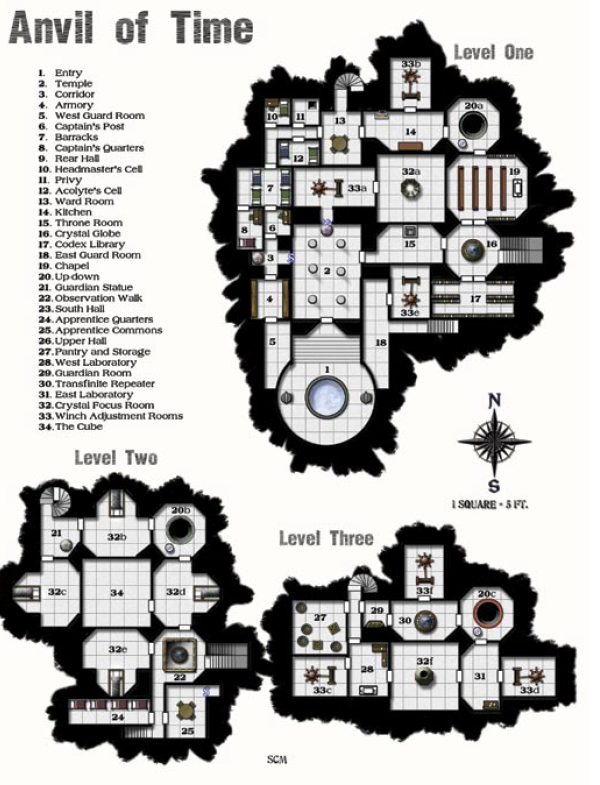
The Anvil of Time Adventure
Some people have already asked in some forums regarding the general playability of time travel. Time Reaver is a 9th-level Sorcerer/Wizard Spell,* while the Device of Time Journeying is in possession of the Master of the Tower of Wayreth and will inevitably fall back into the original owner’s hands if stolen. What of lower-level adventuring parties, and those who do not necessarily want to deal with the aforementioned wizards?
*meaning you’d need to be 17th-18th level to learn it.
Well this adventure provides such an answer with a bonafide time machine dungeon suitable for four 5th-level PCs! The synopsis is that the Anvil of Time is a magical structure built back in the halcyon 2nd Age (Age of Dreams) so that its users could travel through time. An adventurer trapped in the place manages to teleport the PCs into the complex in order to help him get out, and in order to do so they must gather three crystals from the dungeon in different time periods to rebuild the exit portal. Although the overall layout of the dungeon is the same, its inhabitants and state of affairs change based on the time period in question.
Fun Fact: the Anvil of Time was originally published in Dungeon Magazine #86, the first proper Dragonlance Adventure for 3rd Edition. It was written by Tracy Hickman himself to boot, and had very light material on adapting setting material to the new D20 System. It even had some art which wasn’t reprinted in Legends of the Twins, most notably of Huma being a badass. Here’s a few samples:
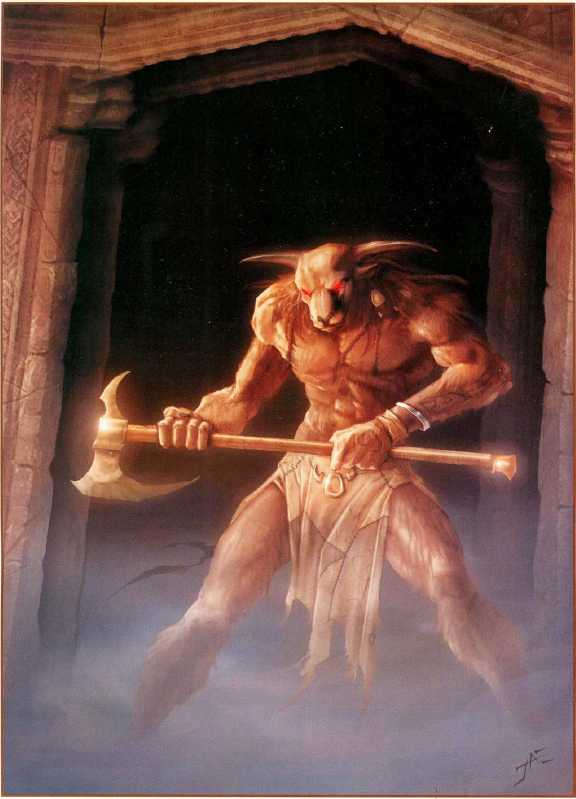
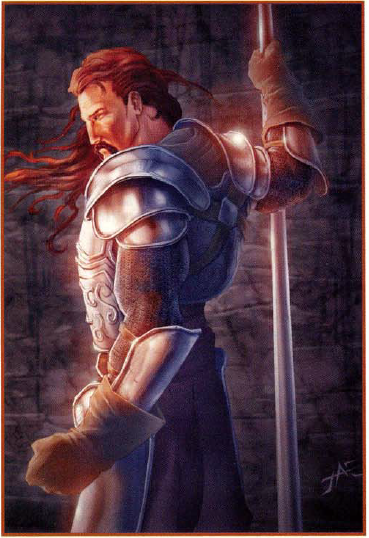
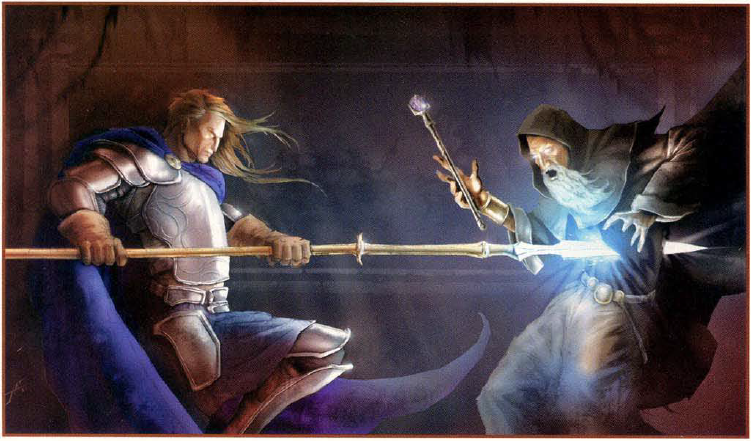
Our adventure opens up during the 4th Age* when they are approached by a bard looking for a means to earn his keep, and offers to tell them a story of Glory or Doom in exchange for a pittance. A story of Glory has him speak of Huma Dragonbane, legendary knight whose example would go on to form the Knights of Solamnia, and one of his lesser-known adventures where he and his good friend Magius pursued a terrible dragon to a mysterious place known as the Anvil of Time. A story of Doom tells of one of Lord Soth’s lesser-known tales when he and a retinue of Solamnic knights in the service of the Kingpriest hunted down a group of Black Robe wizards in a mysterious place known as the Anvil of Time…
Then the PCs teleport in the middle of the tale, a sensation akin to falling from the world through a tunnel of light.
*Age of Despair when the original Chronicles are set
The Anvil of Time is a 34 room dungeon, but the PCs have the opportunity to venture to the same complex during the 2nd Age (Age of Dreams) and 3rd Age (Age of Might). It is in these Ages the PCs can meet the aforementioned characters and their quarries from the bard’s tale. In order to escape the dungeon they must find three transport crystals required for the exit portal’s operation. And as said transport crystals are long-gone in the Age of Despair, they must be found in the earlier Ages. And in order to get into said earlier ages, the PCs must find slips of paper containing Transport Codes detailing the proper number coordinates to time-travel in a special room. The complex’s location proper is beneath the ruins of the City of Lost Names in the wastelands of northern Ansalon, and the adventure discourages the party from exploring too far outside*: obstacles range from a Dragonarmy or Solamnic knight battalion outside in the 3rd or 4th Ages, or being attacked and burned down by red dragons in the 2nd Age. Given that the city in most cases is but a ruined heap and surrounded by wasteland, this feels rather artificial as a barrier.
*a hole in the exit portal room’s roof leads up there.
The adventure is quite descriptive in places on how to set different atmospheres as well as the effects of time travel in the dungeon. During the 4th Age the Anvil’s fallen into disrepair and much of its rooms are dust-choked, its treasure almost entirely stripped by looters. In the Age of Might, Fistandantilus’ wizards have been renovating the place while the archmage’s clone makes use of research in the library. In the Age of Dreams, the place’s foundations are far stronger and while still old are not decrepit. A giant dragon skeleton in the 3rd and 4th Ages is the very dragon Huma and the PCs fight in the 2nd Age, while the after-effects of battle in rooms reconfigure based on said PCs’ actions in earlier Ages. However, you cannot “duplicate” treasure by taking an item from a later Age and going back in time to retrieve it in an earlier Age: there’s only one of said item, and if taken it’s presumed to have been with the PCs all this time in the intervening centuries/millennia.
During the 4th Age the dungeon’s mostly inhabited by ghouls and draconian looters,* both of whom are in a sour mood on account of the Anvil’s relative lack of warm edible flesh and treasure respectively. The person responsible for teleporting the PCs, a disreputable rogue part of a now-slaughtered group of adventurers, is Darmath Goodfellow. He’s eager to use the PCs at a chance of escape and will explain how they need to find the transport gems to power the exit portal. But he is not averse to turning on them if he figures another group has a better chance of helping him escape (or sparing him) and is Chaotic Evil in alignment.
*The 2nd and 3rd Ages have minotaur or Ergothian looters instead, who are opportunistic scavengers hostile to the other factions but will not seek out combat unless they have a clear upper hand or the PCs run into them.
A few rooms contain descriptions of the Anvil of Time’s features, and are quite complicated (averaging one page worth of description per mechanism) so I’m going to sum them up best I can: a Crystal Globe is used to view images of the outside world in the current Age and teleport people into the Anvil of Time, and thus transport people out to a desired location once the coordinates are set. The PCs put the 3 transport crystals into slots to power the device; its current image is the place where they were hearing the bard’s tale, who now appears frozen in time:
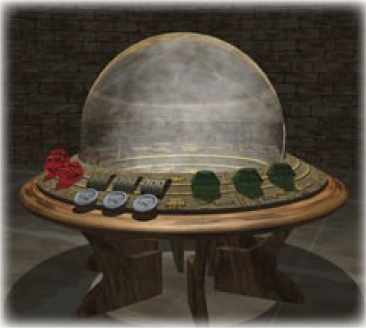
There’s a magical elevator known as the Up-Down which has teleportation portals set in the walls and floors of identical rooms in a continuous loop; you go to a desired floor by grabbing a colored stone corresponding to a specific level from a convenient nearby bowl, and the stone slows down one’s descent until you can safely “air walk” to the proper level:
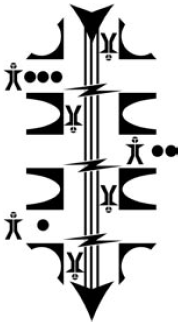
A room containing a device known as a Transfinite Repeater has a rotary display of 12 numbers designed to accept transport codes, and said rotary is changed by cranking one of three giant winches in respective nearby rooms:
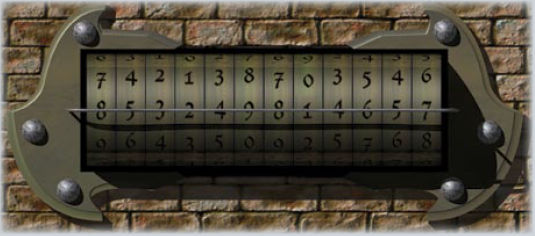
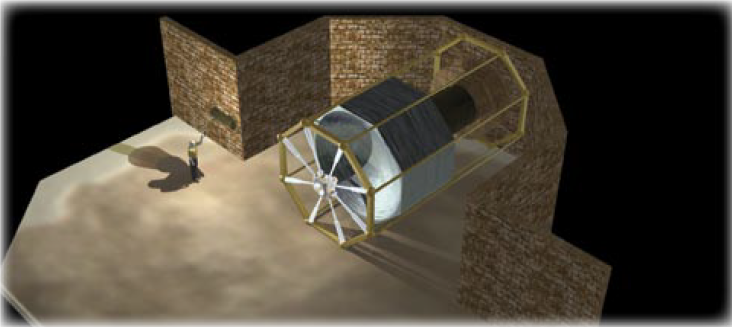
The Transfinite Repeater’s room contains a window looking out into a giant cube straight out of an MC Escher painting:
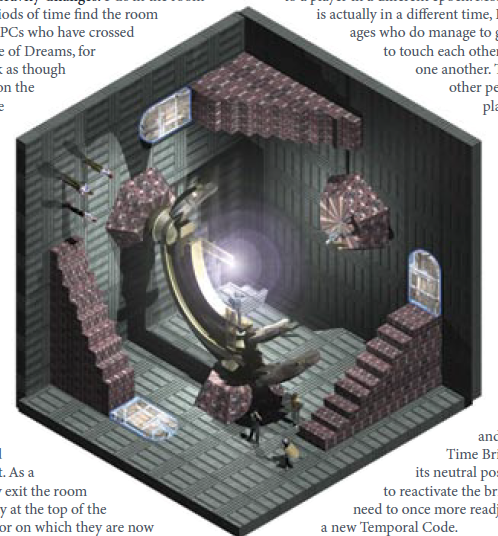
This cube room is the Anvil of Time proper and from which the dungeon derives its name. Each ‘wall’ and floor of the room corresponds to one of Krynn’s six Ages, the final Age being an as-yet unknown and unpublished Age. Entering in a transport code to a certain Age reorients the cube so that said Age is on the floor level. People on the other sides still exist, but are considered to be in a different time period and thus phase through each other and seem to be on their own gravity orientation but can oddly be witnessed and spoken to. This last part will be found out when the PCs encounter a party of elven soldiers on the 2nd Age side who attempt to arrest them for being “suspicious,” only for their arrows to harmlessly phase through the party.
It should be noted that the above devices’ natures can be discovered via successful Knowledge checks or have it explained by an NPC who understands the Anvil’s workings, although besides Darmath the latter options are all in earlier Ages.
The Anvil in the Age of Might: The Anvil at this time takes place a mere few years before the Cataclysm. The dungeon is inhabited by Solamnic Knights who are slowly winning ground against the Black Robe Wizards; the former are suspicious of the PCs and barring a Diplomacy check, aiding them in combat, or a promise to help them kill the mages, they will presume the party to be on the wizards’ side. The wizards are here on a super-secret mission by Fistandantilus and so will not tolerate any intruders. Should the PCs choose not to intervene, the adventure also suggests running combat between the two factions round by round (hah!) or presuming that a given room has the knights win but lost all but 1d10 HP instead. Being squishy arcanists, the wizards will attack intruders through arrow slits and use the Up-Down elevator to attack from different levels.
The PCs can also meet Lord Soth in his pre-evil undead state, but signs of his fall are apparent given his obsessive single-mindedness of the mission. A Simulacrum of Fistandantilus can be fought, and although greatly weakened and running out of spells from earlier combat is still very dangerous on account of having a high caster level and Fireball traps set in strategic choke points by the wily wizard. One other notable encounter includes an animated bronze statue with electrical-powered fists thanks to an internal Wand of Shocking Grasp powering its blows.* A ghostly gnome and former living inhabitant of the Anvil is remote-controlling the statue to defend the complex against intruders, and she initially presumes the PCs to be up to no good.
*and whose charges are drained per attack.
The Anvil in the Age of Dreams: A party of Silvanesti elves are accompanying Huma Dragonbane and Magius in hunting down a red dragon who took refuge in the Anvil of Time. The dungeon at this point is in its best condition, and its rooms have the largest amount of magical treasure. The red dragon has amassed a considerable hoard in the room with the exit portal and is very strong: Challenge Rating 10 with an 8d10 breath weapon and melee attacks all but guaranteed to hit PCs at this level. The adventure recommends making the fight with said dragon super-cinematic, where fire breaths, tail swipes, and area of effect spells cause pillars and walls to break, granting granting access to adjacent rooms and forming debris which can cause damage from falling or serve as cover. Fortunately the PCs have a chance at gaining the aid of Huma and the elven soldiers. The elves are mostly dicks, speak only in an antiquated form of Elven which doesn’t translate perfectly to its modern counterpart, and whose leader is the most likely to meet the PCs on non-violent terms.
Huma Dragonbane and a Silvanesti cleric are in a room inspecting a Dragonlance and trying to figure out its properties, while Magius is in the library and may tolerate an interruption from his research to answer questions. Said ancient library is entirely in the language of the irda (good-aligned ogres) and has a few books of events which have yet to pass in the current history. There’s a few easter eggs of IRL novels with titles such as Draconian Measures and the Annotated Dragonlance Chronicles.
The named NPCs are quite powerful, although not overly-so: Huma is 8th level, Magius 10th, the elven leader and cleric 5th, and the 8 elven soldiers 3rd level Warriors. The dragon’s guaranteed to kill the latter with a well-placed breath weapon and possibly Magius and the Silvanesti leaders with some focused strikes, but with a Dragonlance Huma has a good chance of putting on the hurting. It’s likely that the party can easily overwhelm the dragon due to sheer action economy alone.
And in case you’re wondering, no, Soth and Huma’s parties will not accompany the PCs to different time periods given that they still have much work to do in their own eras. And if Huma is ever in danger of dying then Magius will step in at the last moment and teleport him to safety, for he has a destiny to defeat Takhisis.
When the PCs manage to go through the exit portal, they appear before the bard who continues his story as though nothing happened. He includes some exaggerated descriptions of notable actions two or three PCs performed in the appropriate Age as he finishes the story, and will be surprised at the notice of any new treasure or survivors which seemingly appeared out of nowhere. He will be interested in said unusual changes and ask if the party has any tales worth telling about them.
Magazine/Legends Changes: the bard has his own stat block in the adventure although entirely unnecessary given he never takes part in combat. In the Dungeon Magazine adventure he was a Bard classwise, but to reflect the lack of “primal sorcery/spontaneous spellcasting” during the 4th Age he has levels in Master (Performer). Master can be summed up as Skill User: the Class from the War of the Lance sourcebook. Several other stat blocks are changed to make use of material from the Dragonlance sourcebooks, such as Huma having levels in Knight of the Crown and Magius/Fistandantilus levels in Wizard of High Sorcery Prestige Classes. Lord Soth is a much-stronger 10th level Paladin in Dungeon, but a 7th level Fighter in Legends.
There’s notes on how to scale the adventure for higher or lower-level parties, a common thing in Dungeon Magazine. Most of them involved changing the number of creatures or or changing the red dragon’s age category.
The Silvanesti Warriors and Black Robe Wizard mooks are all dudes in Dungeon Magazine, but in Legends of the Twins are given a more even gender parity.
Darmath’s stat block is reworked to give him a better Bluff check (+8 instead of +3) in the Legends sourcebook given the adventure mentions he will “lie to save his skin.” The ghost gnome’s an Expert in Dungeon, a Rogue in Legends.
There are stat blocks for draconians and kender in the appendix in Dungeon.
Thoughts So Far: This is a pretty nifty dungeon crawl. Some of the time travel and device mechanics may be a bit complicated to explain, which may not be to every group’s liking. The Anvil serves as a useful “home base” of sorts for making forays into other eras, although its remote location on Ansalon places it out of the grasp of the party once they finish said adventure until they travel to the aforementioned City of Lost Names. It feels a bit too easy to end up in combat with the “good factions” in this module, and a bit hard to narratively discuss how the PCs may be on good terms with Soth/Huma/etc when they’re covered in the blood of their companions. And while most encounters are simple “war of attrition” style fights dungeons are renowned for, the presence of allied NPCs risks making the dungeon crawl too easy depending on the PC makeup.
Concluding Thoughts: And so we come to an end of the Legends of the Twins review. I hope that those reading along found it an entertaining one, even if Dragonlance is not everyone's cup of tea.
As to my next review, both choices were popular, but I’m going to begin work on the Towers of High Sorcery. Once I finish that review, I’ll tackle War of the Lance next.